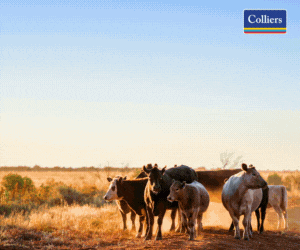- After falling to a nine-year low in October 2023, Australian beef cattle prices have recovered to now be above the 2015-19 average
- The value of Australian beef exports has been on the rise since 2020-21, and has recently been supported by higher export volumes
- The Australian cattle herd is at its highest level since 2014 but is forecast to contract slightly in 2023-24.
Australian beef cattle prices are expected to remain elevated over the next year, supported by improved restocker demand on the back of better seasonal conditions and healthy export demand.
 NAB’s Beef in Focus Report released today reports that after falling to a nine-year low in October 2023, reaching 349c/kg, the benchmark Eastern Young Cattle Indicator (EYCI) is now above the 2015-19 average.
NAB’s Beef in Focus Report released today reports that after falling to a nine-year low in October 2023, reaching 349c/kg, the benchmark Eastern Young Cattle Indicator (EYCI) is now above the 2015-19 average.
In March 2024, the EYCI was 70% above its October lows in monthly average terms.
The upwards trajectory was helped along by seasonal conditions, including the end of the positive Indian Ocean Dipole event and a return to neutral El Nino-Southern Oscillation (ENSO) conditions.
Australia experienced its third-warmest summer on record in 2023-24 but it was also wetter than average. Nationally, rainfall was 18.9% above the Bureau of Meteorology’s recoded long-term average (1916-1990) and in Queensland, it was 30% above the average.
Three out of seven international climate models are currently predicting a La Nina event to develop by August, while the other four models indicate that ENSO conditions will remain neutral.
NAB Group Economics Associate Director Lea Jurkovic said the value of Australian beef exports has been on the rise since 2020-21 and has recently been supported by higher export volumes.
“Demand from the United States has been particularly strong, supported by low slaughter rates after the liquidation of the US herd, which is now at its lowest level in over seven decades following prolonged drought conditions,” Ms Jurkovic said.
“Export demand is also strong from Japan, while China remains the largest destination for Australian beef.”
The Australian cattle herd is at its highest level since 2014 but is forecast to contract slightly in 2023-24.
“Looking forward, strong export demand and an expected increase in saleyard prices will likely contribute to the expected increase in the turn-off rate,” Ms Jurkovic said.
“Female cattle slaughter rates have lifted in recent quarters, consistent with the overall increase in slaughter rates.
“Both Meat & Livestock Australia and ABARES expect the herd to decline over the coming years as slaughter rates increase, though MLA expects a sharper decline earlier.”
Source: NAB
To read the full NAB Beef in Focus Report, see the PDF attached to this email or click here: https://business.nab.com.au/nab-beef-cattle-in-focus-april-2024/
Lea Jurkovic will be discussing the outlook for the cattle industry and managing market volatility and opportunities on Wednesday, 8 May at 11:15am at NAB’s trade stand (site 02) at Beef Australia 2024 in Rockhampton, Queensland.
NAB is hosting free, daily information sessions and morning tea from 6-10 May at the event, which everyone is invited to attend. These short but informative sessions provide an ideal opportunity to hear directly from NAB’s specialists and other experts on a range of hot topics and ask questions.
The full program of NAB’s Beef Australia 2024 information sessions is available here: https://business.nab.com.au/whats-on-at-the-nab-stand-at-beef-2024/</a




Perhaps the NAB needs the prices to stay high …
It’s hard to take any notice of these reports after hearing of elevated high prices for so long ,only to take my cattle to the sale yards and receive mediocre prices at best, time and time again. Let us know where to take our cattle so we can rejoice in some of returns ,that our cattle so rightly deserve, because I’m tired of sending my mates to the slaughter just to half pay a bill.
2015-2019 average? Talk about living in the past!
Ha ha! Come to Echuca sale yards and see how good prices are. Sold directly to local abs 1 330 kg bull in good condition ( bull or steer doesn’t change their price) 90cent per kg lwt.
So don’t blow smoke on how good things are!
I see the grand room of so called experts have come out present prices are going.high for some time. And this after belly gazing at their navels to see.what their smoked crystal balls say.
Time and again they get proved wrong and still they act like experts and ignore their calls that all to often are proved wrong.
Mate when are we going to get our production expenses put on our prices that we recieve at the sale yards 360kg heifers beautifully breed for 425 dollars is a criminal act,do.we discriminate on the super market shelve separating heifer beef from steer beef ,no ,we don’t pass that on to the consumer do we or the farmer or do our expenses get covered until.this is done your notice is lip.service only
Remain Elevated… how about… become Elevated!
I am sorry but my farm has not got any bigger, it carries a few more head. But if $3.49 per kilo 10 years ago prices are so good why is my bank manager kicking me in the guts, and my expenses unpayable?
I take it NAB are not actually using abattoir prices to make their report. Looking at my archived grids, I would say at the moment the offers are pretty similar to what was offered overall during that period and that does count for inflation.
Using the RBA inflation calculator producers in Central Queensland should be getting around $6/kg for 2 tooth Jap export steer to be similar to that 2015-2019 period of time. What is it this week? Something like $5.05-$5.15/kg? Southern producers historically should be getting more.
So from I sit at this point in time prices are not elevated at all and producers are worse off then the 2015-2019 period. NAB might need to get out of the office a bit.
Of course cattle prices will stay High the Australian dollar is 60cents US they can buy our stock for less than they can produce
Well said